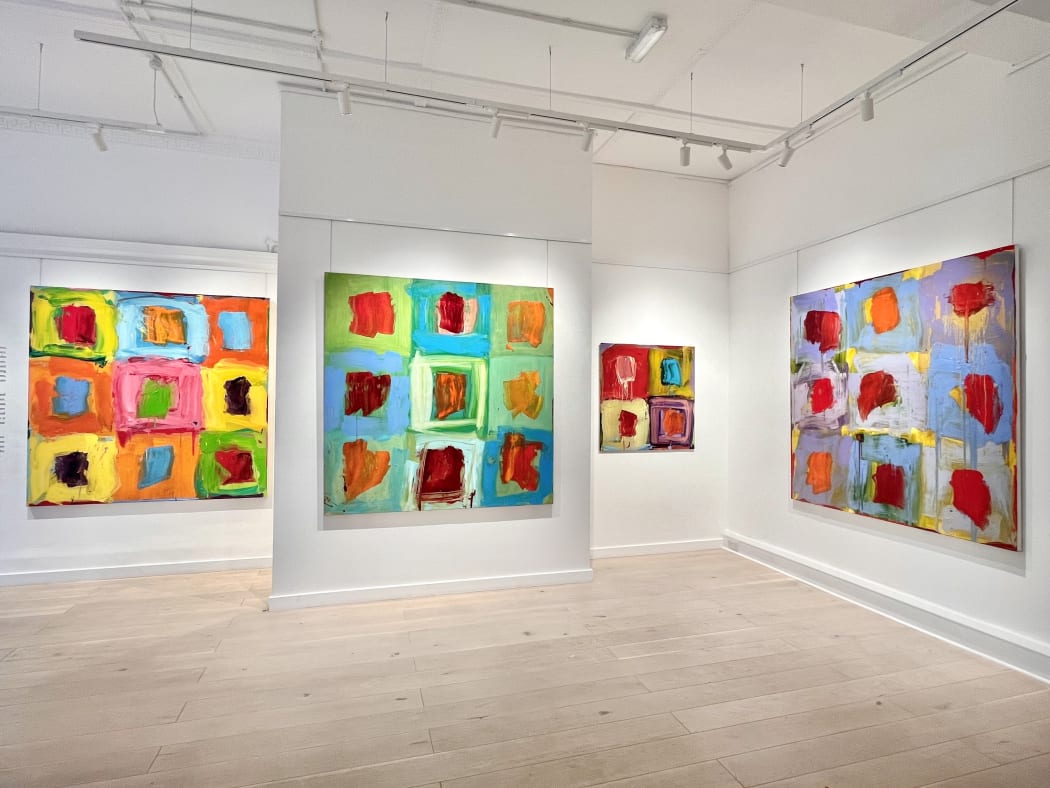
As part of Lucienne O'Mara's first solo exhibition, 'Through the Grid', GJG Gallery Manager, Emma Andreoli, asks O'Mara about her practice and what inspired the use of colourful squares.
Emma Andreoli: Colour obviously takes centre stage in your production; how do you choose your chromatic palette and what do you wish to convey with it?
Luceinne O'Mara: In these paintings colour is meant as much more than just what type of red or blue. It can make a space, fill a space, convey emotion in a way that is hard to pin down with words, and be the carrier of meaning in the work. Colour is also something that can never be seen by itself, even a single colour is always seen in relation to something else. My work is a lot to do with relationships, so I can use colour to explore this.
EA: How do Modernist theories and aesthetic resonate with you and why do you wish to explore them?
LO: The grid is the foundation of my work, it's the structure I use as an entry point to all my paintings.The use of the grid was an important part of developing Modernist painting, it allows for the exploration the picture plane in a way that escapes the signs or symbols attached to figurative painting. It is also a way to concentrate on form, colour, depth and flatness. It's about finding an alternative way of representing meaning, which is what relates most to my work.
EA: What is the role of materiality and gesturalism in your work?
LO:The grid represents order, and it is the thin line holding that together in these paintings that brings the tension, which is why I use such fluid paint.
The combination of the gestural, loose, and emotive brushwork with the structure of the grid almost trying to discipline that materiality, is the key relationship in my work.
It's important to me that the paint has a sense of body, it's not a flat surface. The physical experience of making the work is important, so I want the body to be apparent in the paint.
EA: How did your personal experience influence your practice?
LO: I had an experience which changed the course of my work entirely a few years ago, after a brain injury completely changed my vision and perception of the world around me. Luckily, I was able to retrain my brain, but the experience of learning how to see again was life changing, as for starters it taught me that a lot of our vision is learnt. The experience of suddenly not being able to understand the basic visual cues and signals that we completely take for granted on a day-to-day basis, has been the main drive for my interest in colour, space, light, and form. It has taught me so much about the way we experience the world visually, it was an incredible thing for a painter to experience.
EA: Are there any fellow artist that you feel had a relevant impact on you and your work?
LO: Sean Scully has been a huge influence on me. I think a lot of what I've learnt about colour and depth I experienced for the first time looking at his paintings. I was lucky enough to meet him recently and interview him for Turps Banana magazine which was one of the most interesting conversations I've ever had about abstract painting. He actually has one of my works in his personal collection, which of course is an honour for me.
I also learnt a lot from Georgio Morandi. The use of repetition, looking and looking again until the smallest of shifts in space becomes full of meaning.
Sean Scully and Morandi use this repetitive structure in making, which has been the most important revelation in my work.
EA: What pushes you to explore different pictorial surfaces such as copper?
LO: I'm interested in light, especially the way in colour can absorb it, reflect it, or create space. Working on Copper gives you a surface that has its own light source. Having that starting point to play with has been exciting. The surface is also incredibly smooth and hard, unlike canvas, so it adds an extra level of speed and momentum to the work.
EA: How would you define your work in three words?
LO: Energy, light, colour
EA: What is the significance and relevance of your exhibition's title?
LO: Through The Grid is firstly referencing the importance of the grid structure of squares within squares, but also the way the paintings are transcending that space literally and figuratively. The work is using this structure as an object to create a space to allow you to look beyond.
